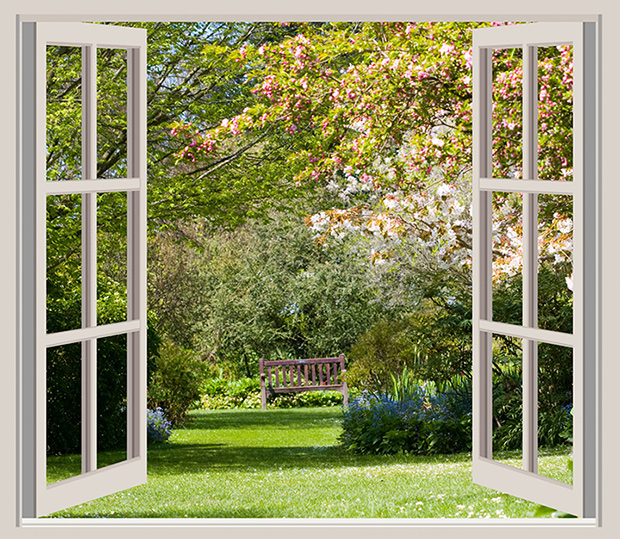 Weatherize your patio door to keep drafts out.
Weatherize your patio door to keep drafts out.
A sliding glass door can be your window to the outdoors, but it can also allow the outdoors to come into your home if it is not properly weatherized. According to the U.S. Department of Energy, sliding glass patio doors tend to lose heat faster than other doors, but with proper weatherstripping, you can decrease the amount of air leakage around the door and reduce drafts. Avoid losing heat in the winter and cool air in the summer by weatherizing your sliding glass door.
Remove the sliding panel from its frame. Depending on the style of sliding glass door, there are different ways to accomplish this. One method requires grasping both sides of the sliding panel and lifting it up inside the track as far as possible to clear the bottom track. Tilt the bottom of the panel toward you and carefully lower the panel from the top track. Another method requires removing the screws from the top railing covering the door track to release the railing from the frame. Tilt the top of the panel toward you and then lift it from the bottom track. Or, your door may have two roller adjustment screws along the bottom of the panel. Turn the screws counterclockwise to retract the rollers on the panel. This allows you to tilt the top of the panel toward you and then lift the panel from the bottom track.
Move the panel to a sturdy work surface or carefully lay it on an old blanket on the ground.
Pull the old vinyl weatherstripping from inside the sliding glass door frame. Some weatherstripping slides into grooves and is held to the frame by pressure, while other weatherstripping is held by adhesive. Use a safety scraper to remove any adhesive residue.
Insert a flat-heat screwdriver beneath the old brush-fin weatherstripping inside the top and bottom sliding glass door tracks. Peel the old brush-fin from the tracks.
Vacuum the sliding glass door track to remove any dirt and debris. Spray a multipurpose cleaner and degreaser into the track and scrub with a nylon scrub brush. Rinse the cleaner from the track and wipe it dry with paper towels.
Peel the old weatherstripping from the upright end of the stationary glass door panel where the sliding panel overlaps the stationary panel. If your door has a vinyl frame instead of aluminum, the weatherstripping may be secured to the stationary panel with staples. Use needle-nosed pliers to pull the staples from the panel to release the old weatherstripping.
Scrape any adhesive residue from the upright with the safety scraper. Clean the upright with the cleaner and wipe it dry.
Remove the old weatherstripping from the sliding panel that corresponds with the weatherstripping on the upright. Clean the sliding panel with the cleaner and wipe it dry.
Install the side of the interlock pile weatherstrip that has brushlike fibers onto the stationary upright. Use a self-adhesive interlock pile on an aluminum door or secure it to the upright with a staple gun loaded with heavy-duty staples if your sliding glass door frame is made of vinyl. Place the other side of the interlock weatherstrip onto the sliding panel. Staple the weatherstrip in place if you have a vinyl door.
Insert new brush-fin weatherstripping into the top and bottom sliding glass door tracks. Peel the protective paper from the adhesive backing before inserting each weatherstrip. Firmly push the strip into place. Use a utility knife to trim both ends to ensure that the weatherstrip sits flush inside each track.
Install the sliding panel into the door frame. Reverse the steps you used to remove your door from the track and frame.
Replace the vinyl weatherstripping along the inside edge of your sliding glass door frame. Make sure you match the new weatherstripping to the old weatherstripping you removed previously. Some weatherstripping snaps into a small groove along the inside edge of the frame, and other weatherstripping adheres to the frame with a self-stick backing.
Remove the old caulk from around the outside edge of your sliding glass doorframe. Peel the old caulk from the frame with a putty knife. Use the utility knife to cut through areas of caulk that the putty knife cannot get under. Use your fingers to peel the remainder of the caulk from around the door frame. Brush around the sliding glass door frame with an old paintbrush to remove any dirt and debris.
Insert a tube of acrylic latex caulk with silicone into a caulking gun. Some caulks come in colors that can match your brick or paint, saving you the trouble of painting the caulk once it dries. Cut the tip from the end of the caulk with the utility knife, ensuring that the width of the tip is slightly wider than the gap between the door frame and your exterior wall.
Position the tip of the caulk tube against the top corner of the sliding glass door frame. Apply pressure to the caulking gun trigger to apply an even bead of caulk down the edge of the frame. Apply the caulk along the top of the frame and then down the remaining side.
Smooth the bead of caulk with your finger. Start at the top corner and work your way down the sides of the sliding glass door. Smooth the caulk across the top of the door frame. Wipe away any excess caulk with a damp cloth.
Things You Will Need
- Flat-head screwdriver
- Old blanket
- Safety scraper
- Vacuum
- Multipurpose cleaner and degreaser
- Nylon scrub brush
- Paper towels
- Needle-nose pliers
- Two-piece interlock pile weatherstrip
- Staple gun
- Heavy-duty staples
- Brush-fin weatherstripping
- Utility knife
- Vinyl weatherstripping
- Putty knife
- Old paintbrush
- Acrylic latex caulk with silicone
- Caulking gun
- Cloth














Plantation shutters are an extremely popular window treatment these days. They provide a nice elegant look to your home as well as offering great privacy and light control. Plantation shutters are on the higher end of window treatments when it comes to cost which is why some people choose another window treatment option. But the people that do choose to go with plantation shutters, often times will neglect their sliding glass door. They simply just do not know that plantation shutters are even an option for them. The fact is, you can install plantation shutters for your slider, and they…